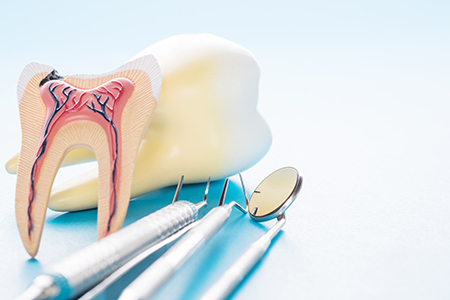New Patients
(865) 876-7050
Existing Patients
(865) 947-2220

If a dentist advises that a tooth needs a root canal, there’s no reason to panic. Modern root canal therapy is a precise, commonly performed procedure designed to relieve pain, control infection, and preserve your natural tooth whenever possible. In most cases the experience is comparable to having a routine dental filling, thanks to local anesthesia and gentle techniques.
At the office of Kennedy Dentistry, we combine up-to-date technology with a patient-first approach to make endodontic care straightforward and as comfortable as possible. Our focus is on clear communication, thoughtful pain control, and long-term outcomes so you can return to normal function and smiling with confidence.
Teeth are meant to last a lifetime, and root canal therapy is one of the primary ways dentists preserve a natural tooth that would otherwise need extraction. When the internal tissues of a tooth — the pulp — become infected or irreversibly damaged, removing the diseased material and sealing the canal system preserves the outer tooth structure and restores oral function.
Success rates for contemporary root canal treatment are high when performed with careful technique and appropriate follow-up restorations. Saving the natural tooth helps maintain chewing efficiency, prevents neighboring teeth from shifting, and preserves the underlying jawbone — all important contributors to long-term oral health.
Choosing root canal therapy over extraction often reduces the need for more involved restorative work later. With a properly restored tooth, most patients regain full comfort and function while avoiding the additional procedures required to replace a missing tooth.

Inside each tooth is a chamber that houses the dental pulp — connective tissue, nerves, and blood vessels that support the tooth during its development. When decay, deep restorations, repeated dental work, or trauma compromises that tissue, inflammation or infection can set in and make the tooth painful or vulnerable to further damage.
Symptoms that often accompany pulpal problems include lingering sensitivity to hot or cold, pain when biting, swelling of the surrounding gum, or a tooth that appears darkened compared with neighboring teeth. Sometimes a tooth has no obvious symptoms and the issue is first detected on a routine radiograph or clinical exam.
If pulp damage progresses without treatment, the infection can reach the tip of the root and affect surrounding bone. Timely evaluation and treatment are important to avoid more extensive complications and to improve the likelihood of a favorable outcome.
Warning signs that merit prompt dental assessment include the following:
Persistent tooth pain — especially pain that interrupts sleep or lingers after exposure to hot or cold — is a common signal of pulpal inflammation or infection and should be evaluated without delay.
Teeth that react intensely to temperature changes or stay sensitive well after the stimulus is removed can indicate irritated or dying pulp tissue that may require treatment.
Pain on chewing or tenderness to tapping often points to involvement of the tooth’s nerve or supporting structures and warrants professional evaluation.
A darkening tooth can result from internal changes following trauma or long-standing pulp damage. While not all discolored teeth need root canal therapy, discoloration is a sign that the tooth should be assessed.
Structural damage that exposes the inner portions of a tooth can lead to pulp injury or bacterial invasion; in many cases, root canal therapy is required to preserve the remaining tooth.
Localized swelling or drainage near a tooth may indicate an abscess or advanced infection — conditions that need prompt attention to prevent spread and further complications.
Advanced pathology around a tooth can weaken the supporting bone and ligaments, sometimes causing the tooth to feel mobile. Addressing the source of infection can often preserve stability.

When signs point to a compromised tooth, prompt care increases the chance of a successful outcome and reduces the risk that the problem will affect adjacent teeth or the jaw. Early treatment limits the spread of infection and preserves more of the natural tooth structure.
Some teeth with pulp disease show no immediate symptoms and are discovered during routine exams or X-rays. In those cases, treating the tooth before symptoms appear can simplify the procedure and improve recovery.
Delaying care can allow an infection to become more extensive, increasing the complexity of treatment and the likelihood that additional procedures will be needed. For this reason, regular dental checkups and quick attention to new symptoms are important preventive measures.
Contemporary root canal therapy combines magnification, reliable local anesthesia, and precise instruments to clean the root canal system efficiently and comfortably. Most treatments are performed in a single visit, though some cases require multiple appointments depending on anatomy or the presence of active infection.
During the procedure, the dentist isolates the tooth, creates an access point, and carefully removes damaged pulp. The internal canal space is shaped, cleaned with disinfecting solutions, and then sealed with biocompatible filling material to prevent recontamination.
When anxiety is a concern, additional comfort options are available to help patients relax. Once the root canal is completed, the tooth will typically require a protective restoration — often a crown — to restore strength and long-term function.

Our team at Kennedy Dentistry makes post-treatment recovery a priority. After a root canal you can expect some tenderness around the tooth for a few days as surrounding tissues heal, but the intense pain caused by the original infection is usually relieved once the diseased pulp has been removed.
Follow any instructions your dentist provides regarding medications, oral hygiene, and eating. While the tooth may have a temporary filling, it is important to avoid chewing hard or sticky foods on that side until a permanent restoration is placed to prevent fracture.
Long-term success depends on completing the recommended restoration, practicing good daily oral hygiene, and attending regular dental exams. With appropriate care, a root canal–treated tooth can remain healthy and functional for many years — often for a lifetime.
After your root canal, you may notice some of the following and what to do about them:
Anesthesia used during the appointment can leave the area numb for a few hours. Take care not to bite your lip or tongue until feeling returns.
Mild to moderate soreness is normal as tissues recover. Over-the-counter pain relievers typically manage this discomfort; follow any specific guidance from your dentist.
If an antibiotic or other prescription is provided, complete the full course exactly as directed to support healing and reduce the risk of persistent infection.
Limit chewing on the treated tooth until it has been permanently restored. A crown or appropriate restoration will protect the tooth and restore full function.
Continue gentle brushing and flossing to keep the area clean and support healing. Good daily care and routine dental visits are essential for long-term success.
Placing a permanent crown or restoration as recommended strengthens the tooth and reduces the chance of future complications.
With careful technique, appropriate follow-up, and good oral hygiene, root canal treatment is a reliable option for saving a tooth and restoring comfort and function.
If you have questions about symptoms, treatment options, or what to expect, contact us for more information. Our team can help you understand the recommended plan and support your recovery every step of the way.
A root canal procedure is the best way to save a tooth that has been damaged by decay or injury and preserve your natural smile. The alternative is an extraction and treatment to replace the tooth. While at times a tooth is non-restorable and an extraction is the only option, when possible, it’s best to try and save your natural tooth. With proper care, a tooth with root canal therapy can serve your smile well for many years to come.
Despite lingering myths from before the age of modern dental anesthesia and technology, having a root canal procedure today is as routine and comfortable as visiting the dentist for a filling. While the procedure is performed under local anesthesia with your tooth completely numbed, we can also discuss options in dental sedation.
Whether the symptoms of a dental infection subside after a course of antibiotics, a draining abscess provides you with some temporary pain relief, or a tooth with radiographic evidence of pathology has not yet developed symptoms, it’s essential, before an infection worsens or occurs, to have a root canal procedure performed. In this way, the tooth can be disinfected, filled, and sealed to protect your health and avoid further problems.
If you have sustained a dental injury, have a toothache, jaw pain, swelling, or are experiencing any other unusual and uncomfortable oral symptoms, contact our office immediately for care. Dental problems that have not been evaluated and treated can significantly worsen, producing more severe damage and consequences for the involved teeth, your oral health, and even your overall wellbeing. Once you get in touch with our office, our friendly and compassionate office team will get you in for care at your earliest convenience.
While some root canal procedures can be completed in one visit, others may involve 2 or 3 appointments. How long it takes depends on various factors, including active infection, the number of canals in the tooth, and the tooth’s location or anatomy.
With a success rate that exceeds 95%, root canal therapy remains the most effective procedure to save a tooth in which the inner vital tissues have been damaged. However, as with all healthcare procedures, there are a small percentage of cases where the teeth become symptomatic a second time. The good news is that many of these teeth can still be saved with root canal retreatment or a minor surgical procedure known as an apicoectomy.
The best ways to maintain a tooth with root canal therapy are to get the proper restoration required to rebuild and protect the tooth, maintain proper oral hygiene, and schedule appointments for routine dental checkups and care.
Saving a tooth with root canal therapy is a wise investment that, in the long run, is typically less costly and invasive than having the tooth extracted and replaced with a fixed bridge or implant. As far as the exact cost of care, it can vary depending on which tooth is being treated. Many dental insurance plans provide coverage for root canal therapy. At the office of Kennedy Dentistry, we do our best to optimize your dental benefits and minimize your out-of-pocket expenses. Our staff will answer all your questions about the cost of care and discuss all your payment options.
At the office of Kennedy Dentistry, we use the latest technology and most effective methods of care to provide precise and gentle care. Our reputation for excellence is based upon a consistent record of achieving successful treatment outcomes while providing prompt, stress-free, and convenient treatment for every type of dental need.
